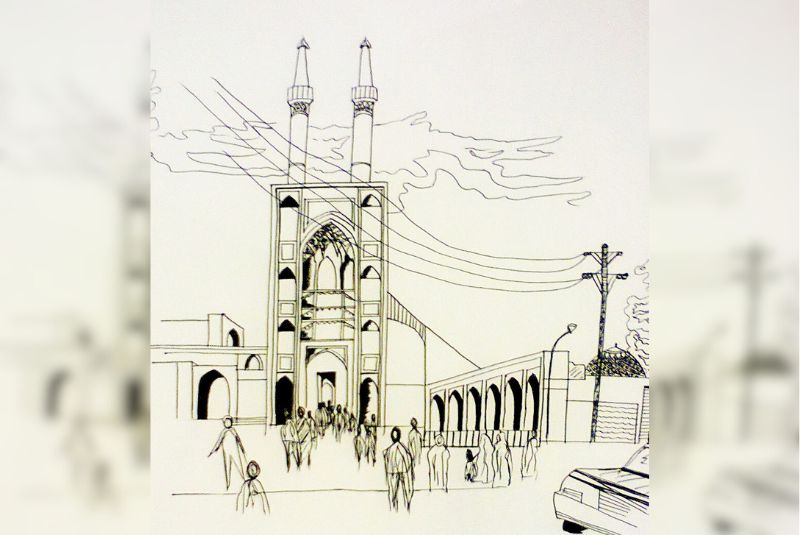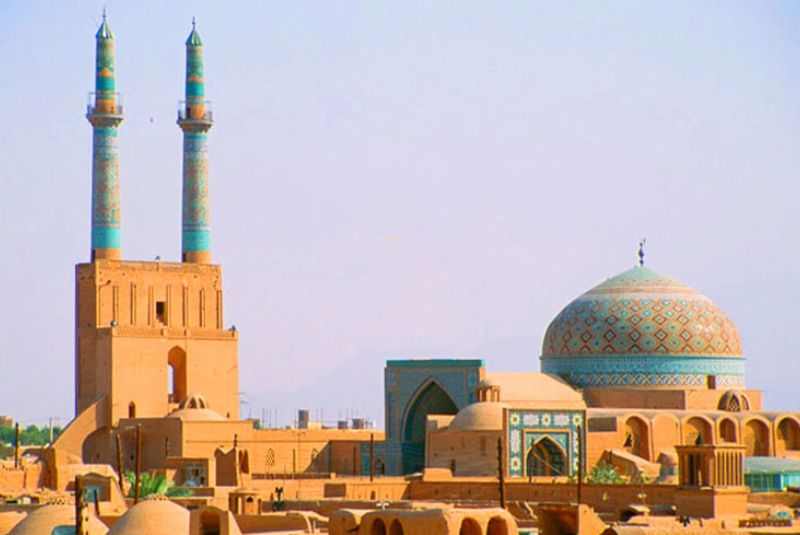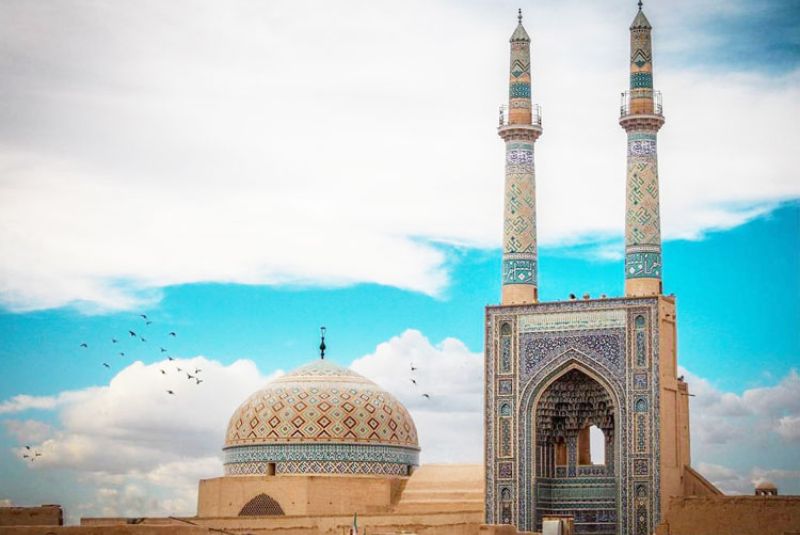Jameh Mosque of Yazd: A Religious/Historical Must-Visit
Many of Yazd's attractions are historical sites, featuring unparalleled Iranian architecture that each narrates a fascinating story about the city's history. Among the most famous of these historic buildings, located in the city center, is the Jameh Mosque of Yazd.
The Jameh Mosque of Yazd is essentially a combination of three mosques, constructed over various historical periods. It boasts the tallest minarets among its peers and is designed in a square shape inspired by the Kaaba.
The initial structure was built atop a Sassanian fire temple. Historically, three mosques once stood on this site, but the current mosque has replaced them, unifying the area into a single, expansive courtyard.
The Jameh Mosque of Yazd is now a prominent attraction in the city, having been registered as a national heritage site in 1934 and inscribed on the UNESCO World Heritage list in 2017. Join us as we explore the fascinating history and architectural marvels of the Jameh Mosque of Yazd.
Interested in visiting Jameh Mosque of Yazd?
Check out our Yazd tour packages to find an itinerary that includes visiting the mosque
or...
Design your own tailor-made itinerary and include Yazd Jameh Mosque in it by yourself, today!
History of the Jameh Mosque of Yazd

The construction and completion of the Jameh Mosque of Yazd spanned a century and took place across various historical periods, including the Ilkhanate, Safavid, Timurid, Al-Muzaffarid, and Qajar dynasties. Each section of this historic structure was built and restored over time by different patrons.
The mosque’s foundation dates back to the Sasanian era, originally built on a Zoroastrian fire temple. The present structure, however, mainly stems from the Qajar period.
During the reign of Fath-Ali Shah Qajar, extensive demolition and reconstruction took place, resulting in the mosque's current appearance, which significantly differs from its original form.
| Suggestion: Amir Chakhmaq Complex - What to See in Yazd, Iran
Atiq Jameh Mosque
According to historical records, the current mosque stands on the site of three earlier mosques that were built next to each other over the years. The first of these, known as the Atiq Jameh Mosque, was designed and constructed in the late 9th century CE (3rd century AH) during the rule of Amr ibn al-Layth al-Saffari.
This part of the structure was repaired and restored in the 11th century CE (5th century AH), and a minaret was added, which remained a prominent feature for centuries.
Old Jameh Mosque
In the 11th century CE (5th century AH), Alaa-od-Dowleh, a ruler of Yazd, initiated the construction of the second mosque, known as the Old Jameh Mosque. He added a dome chamber and several iwans (halls) to the original mosque. After his time, the daughters of Faramarz ibn Kakouei facilitated the construction of new sections, including a prayer hall and a mausoleum adjacent to the second mosque.
New Jameh Mosque
The third mosque, called the New Jameh Mosque, was built in the early 14th century CE (8th century AH) with a small courtyard, a dome chamber, and a large iwan.
This mosque was constructed under the direction of Rukn al-Din Muhammad ibn Qavam al-Din Muhammad ibn Nizam al-Hosseini Yazdi Qazi, who tirelessly pursued its completion.
Unfortunately, Seyed Rukn al-Din passed away before the building was finished, leaving the dome and iwan incomplete. Sharf al-Din Ali Yazdi completed these structures in 1332 CE (732 AH).
Timurid Period
In 1375 CE (777 AH), during Amir Timur's reign, the dome and iwan were adorned with tile work. Khwaja Jalal-ud-Din Mahmoud Khwarazmi, Amir Timur’s son, added an inscription in Naskh script around the dome and iwan, written by the famous calligrapher Baha-ud-Din Hazarasp.
Although this inscription, which included Surah Al-Fath, was not completed in Mahmoud Khwarazmi’s time, it was finished in 1416 CE (819 AH) during Shahrukh Mirza’s rule by Nizam Kermani. In the same year, Shahrukh Mirza ordered that the names of the Twelve Imams and his titles be inscribed on a tile at the grand entrance portal.
Today, the Jameh Mosque of Yazd stands as a testament to the city's historical and architectural legacy. It was registered as a national heritage site in 1934 and was inscribed on the UNESCO World Heritage list in 2017, further cementing its status as one of Iran's most significant cultural landmarks.
Architecture of the Yazd Jameh Mosque of Yazd

The architectural design of the Jameh Mosque of Yazd combines a domed chamber (maqsurah) and a long rectangular prayer hall (shabestan). The mosque's main plan is quadrangular, which is considered an imitation of the Kaaba's plan.
According to the late architect Mohammad Karim Pirnia, the mosque follows the Azari style, also known as the Mongol or Persian-Mongol style. Examples of this style can also be seen in buildings in Herat and Bukhara.
| Related: Elements of Persian Architecture
Different Sections of the Masjed Jameh Yazd

Entrance Portal
The grand entrance of the Jameh Mosque of Yazd is a stunning feature, reaching up to 24 meters in height. It includes several archways and two minarets. The entrance is adorned with the titles of Shahrukh Timuri and Mirza Jahanshah, written in Naskh script. Inside the eastern entrance, there is an inscription detailing the mosque's endowment from the year 765 AH, the oldest recorded inscription in the building.
Lighting
The mosque is illuminated indirectly through the reflection of light off the white plaster of the dome and walls, creating a serene and luminous atmosphere.
Shiite Symbols:
Throughout the mosque, many Shiite symbols can be found, forming a significant part of its decoration. Notable among these are the five-pointed star, representing the five principles of Islam, the Panjtan (the five holy figures in Shia Islam), and the five major prophets. The 72-pointed and 12-pointed sunbursts (shamsa) are also prominent motifs seen in various parts of the mosque.
| Read more: Chak Chak Pilgrimage Site - A Cultural Gem in Yazd, Iran
Decorative Elements
The mosque is richly decorated with tile work, stucco carvings, and calligraphy. The intricate designs and motifs reflect the artistic achievements of the various periods during which the mosque was constructed and renovated.
Eastern Vestibule
In front of the eastern entrance, there is a vestibule with an octagonal pool and two marble columns with carved animal and plant motifs, along with two verses inscribed in Naskh script. Unfortunately, the inscriptions are not fully legible due to damage.
Main Courtyard
The main courtyard serves as the central area for prayer. It features a mihrab adorned with blue tiles inscribed with the names Allah, Muhammad, Ali, Hasan, and Hussein. Previously, two qanats (underground water channels) existed in this courtyard, but they are now dry.
Main Iwan
The main iwan is rectangular and features two large columns decorated with calligraphy in Naskh and Kufic scripts. The ceiling is adorned with Kufic inscriptions of the names of God.
| Discover: Sarv-e Abarkuh (Cypress of Abarkuh) - A 4000 Years Old Tree in Yazd
Dome Chamber
The dome of the mosque consists of two layers and features geometric decorations on the inside.
Eastern Prayer Hall
Dating back to 1375 AD, the eastern prayer hall was built by order of Shah Yahya Muzaffar. The main mihrab of the mosque is located here and is one of its most striking features, decorated with intricate tile work, plasterwork, and muqarnas (stalactite-like decorations). The completion date and the architect's name are inscribed on either side of the mihrab.
Western Prayer Hall
The western prayer hall measures 38 by 9 meters and is decorated with lattice windows and tile work. It was built during the reign of Amir Ghiyas and is also known as the Ghiyasiyeh. Currently, it houses the museum of the Jameh Mosque of Yazd.
Vaziri Library
Adjacent to the main entrance of the mosque stands the Vaziri Library, one of Iran's renowned libraries. Established in 1334 AH by Ali Mohammad Vaziri, this library has a rich history and holds a vast collection of ancient manuscripts and printed books.
Mihrab (Prayer Niche)
The highlight of the Jameh Mosque of Yazd is its intricately decorated mihrab, embellished with gypsum and mosaic tilework, depicting floral motifs and the Quranic verse "So God is sufficient for you, for He is the All-Hearing, the All-Knowing" in bold calligraphy.
| Discover: The Water Museum in Yazd
Minarets
The minarets are among the most majestic features of the mosque, standing 52 meters tall with a diameter of 8 meters. They are decorated with intricate tile work featuring the names of God and the Imams.
One of the minarets has a single staircase, while the other has two. They were constructed by Aga Jamaluddin Muhammad, known as Mehtar Jamal, a minister of the Safavid era. These minarets collapsed in 1934 and have since been restored.
Qanat and Water Wells
The Jameh Mosque of Yazd boasts the honor of housing the oldest and longest qanat in the world, known as the Zarch Qanat, which passes beneath the mosque. The architectural layout of the mosque ingeniously incorporates this historical feature, underscoring its significance.
Museum of the Jameh Mosque
The museum, established in 2014, displays historical artifacts related to the mosque and the Islamic period, including:
- Photographs of the mosque from 1933 onwards.
- Pieces from the mosque's restorations.
- Golden tiles from the Ilkhanid period (14th century).
- Mosaic tiles from the Timurid period (15th century).
- Seven-color tiles from the Qajar period.
- Mosaic tiles from the early Pahlavi period.
- A marble pulpit from the Qajar period.
- A wooden clock donated by Haj Mohammad Ali Vaziri in 1945.
- A collection of zilu (traditional Persian rugs).
- A piece of the Kaaba’s covering, gifted by the King of Saudi Arabia in 1966.
- A walnut door with intricate wood carvings from the Afsharid period.
| Read more: A Guide to the Towers of Silence in Yazd, Iran
Location of Jameh Mosque of Yazd
The Jameh Mosque of Yazd is located on the western side of Imam Khomeini Street in Fahadan neighborhood in Yazd.
Jameh Mosque of Yazd Nearby Attractions

Several notable attractions are located near the Jameh Mosque, offering additional opportunities for exploration:
- Distance to Lari House: 800 meters
- Distance to Vaziri Museum: 250 meters
- Distance to Clock Tower Square: 500 meters
- Distance to Alexander's Prison: 600 meters
- Distance to Coin and Anthropology Museum of Heydarzadeh: 600 meters
- Distance to Amir Chakhmaq Square Complex: 1.3 kilometers
| Suggestion: Best Hotels in Yazd for a Memorable Stay
Jameh Mosque of Yazd Entrance Fee
Visiting the Jameh Mosque of Yazd is free for Iranian citizens, while the museum ticket price (as of 1400) is 2,000 Tomans. Foreign visitors, however, need to pay 20,000 Tomans for entry to the mosque (as of 1400).
Opening Hours of the Mosque
The mosque is open for visits from 8:00 to 19:30, while the museum operates from 9:00 to 14:00 in summers and from 9:00 to 18:00 in winters.
Best Time to Visit Jameh Mosque of Yazd

To fully appreciate the intricacies of the mosque, it's recommended to visit during daylight hours. However, the mosque takes on a different charm with its illuminated architecture during the night, providing a cooler atmosphere for exploration.
| Suggestion: 10 Best Restaurants in Yazd - Foodies Ultimate Guide
Tips for Visiting Jameh Mosque of Yazd

- Respect Dress Code: Since it's a religious site, dress modestly out of respect for the mosque and its worshippers.
- Mind Your Behavior: Maintain a respectful demeanor and avoid making loud noises or disruptive gestures.
- Take off Your Shoes: Follow the custom of removing your shoes before entering the prayer hall to show reverence for the sacred space.
- Observe Quiet Hours: During prayer times, refrain from talking loudly or taking photos in the prayer hall out of respect for worshippers.
- Explore Architecture: Take your time to appreciate the intricate architectural details and historical significance of the mosque.
Bottom Line
The Jameh Mosque of Yazd stands as a testament to the rich architectural heritage and historical significance of the city. Its fusion of three mosques, built over different epochs, creates a captivating narrative of religious and cultural evolution.
With its towering minarets and a square design reminiscent of the Kaaba, the mosque exudes a sense of grandeur and spiritual reverence.
As a registered national heritage site since 1934 and a UNESCO World Heritage site since 2017, the Jameh Mosque of Yazd attracts visitors from around the world. As we bid farewell to this historic gem, we carry with us not just memories of its beauty, but a deeper appreciation for the enduring legacy it represents.
Share your story!
Comment below and let us know about your Experience.
Your story inspires others!


Comment
Leave a Comment